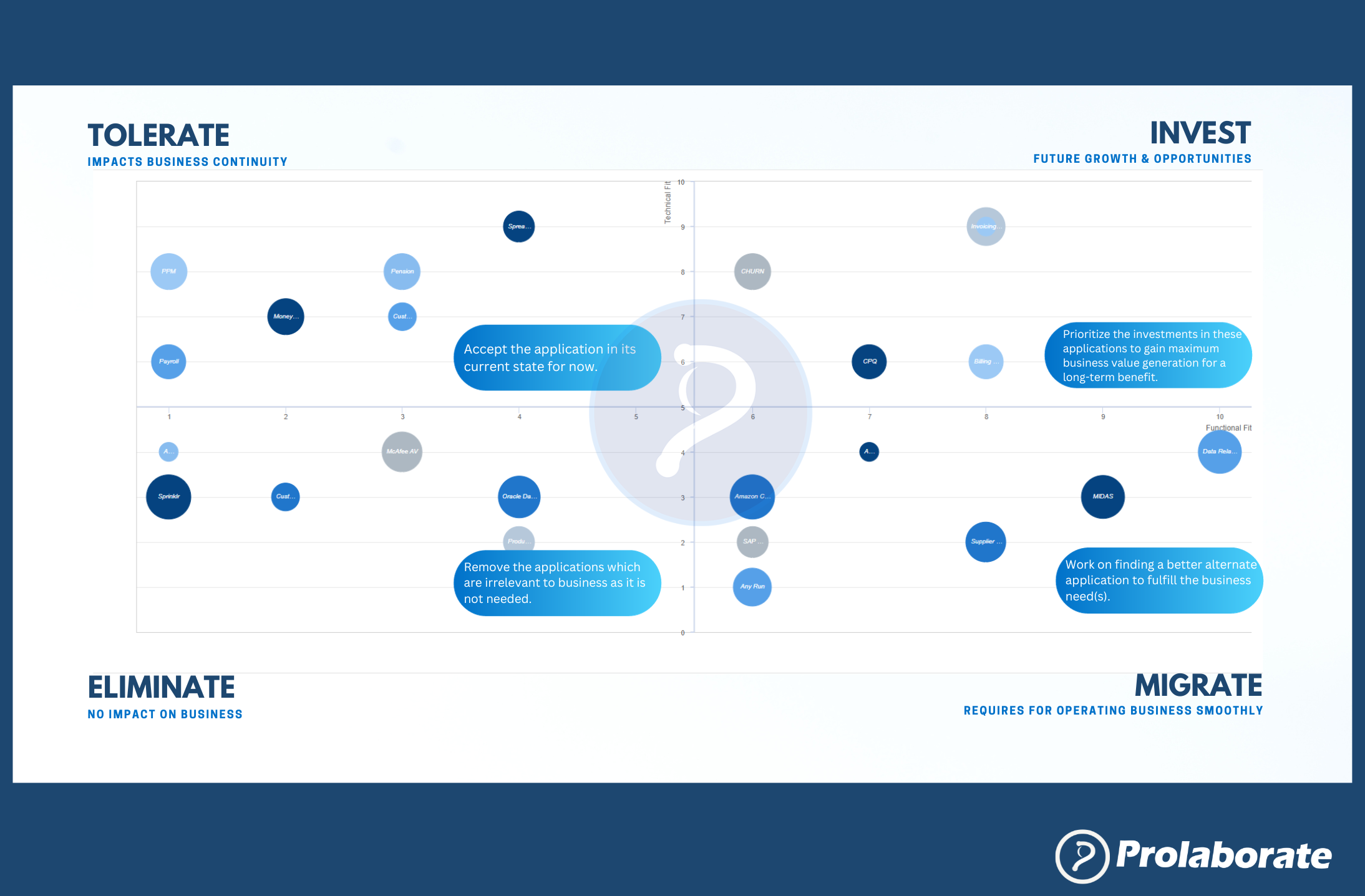Gartner’s T.I.M.E Chart – One of the most influential charts in Application Portfolio Management
Updating sting The T.I.M.E Chart plays a crucial role in Application Portfolio Management by providing a strategic framework to optimize the business value of an application portfolio and assess the suitability of each application within an organization.
TIME chart has been extensively tested and proven effective in evaluating and classifying applications based on their technical and functional compatibility with the organization.
One of the key features of the T.I.M.E Chart isapplication rationalization.
This approach allows architects to streamline their decision-making process regarding which applications to retain, enhance, replace, or retire. By adopting this approach, organizations can experience cost reductions, improved efficiency, and alignment of the IT portfolio with the overall business objectives.
But what exactly is the T.I.M.E Chart?
Let’s delve into its four pillars to gain a deeper understanding.

Tolerate
Applications categorized as “Tolerate” have a strong technical compatibility but a limited functional fit. While they may not hold strategic importance, they are not considered a priority for modification or removal due to their satisfactory technical performance. Despite their minimal contribution to business goals, these applications are often maintained in their current state. The decision to tolerate an application is typically based on the cost and effort involved in replacing or upgrading it. If the expenses outweigh the potential benefits of change, the application is tolerated until a more favorable time for modification presents itself.
Invest
On the other hand, “Invest” applications possess both high technical and functional compatibility. They play a crucial role in the organization’s operations and significantly contribute to achieving business objectives. These applications are generally of high quality and are utilized on a daily basis to support important business functions. The decision to invest in an application is driven by its potential to provide added value to the business. This can manifest in various ways, such as improved efficiency, enhanced functionality, or the ability to support new business initiatives.
Migrate
Applications categorized as Migrate are those that have a high level of functional suitability but a low level of technical suitability. These applications play vital roles in performing important functions, but they lack the necessary technical capabilities. As a result, they are often replaced with more efficient alternatives, frequently in the form of cloud-based solutions. The decision to migrate an application is typically motivated by the desire to enhance technical performance, decrease costs, or align more effectively with the organization’s IT strategy. Most of the migration fail because lack of planning hence is essential to carefully plan and execute the migration process in order to minimize any disruptions to business operations that may occur.
Eliminate
Applications falling under the Eliminate category exhibit both low technical and functional suitability. These applications no longer perform adequately and are no longer aligned with the organization’s current business activities. Consequently, they are targeted for removal from the application portfolio. The decision to eliminate an application is usually driven by the need to reduce costs, simplify the IT landscape, or mitigate risks associated with outdated software. The elimination process can be complex and requires meticulous planning to properly manage dependencies and ensure a seamless transition for users. In both cases, whether migrating or eliminating an application, careful consideration and strategic planning are crucial to ensure a successful outcome.
Let’s explore the benefits and productivity of implementing T.I.M.E in Application Portfolio Management (APM) for APM at Prolaborate.
- APM entails taking a comprehensive view of the business applications within an enterprise landscape to facilitate better application rationalization.
- By centralizing and managing the inventory of applications, stakeholders gain clarity on various aspects such as responsible parties, cost of operations, technological obsolescence, lifecycle, data classification, security risks, and other key attributes.
- This real-time visibility provides valuable insights for stakeholders to make informed decisions that drive key business outcomes.
So, why is Application Portfolio Management important?
- Firstly, it enables data-driven decision-making regarding investments in, sustenance of, or replacement of business applications. By evaluating the value and efficiency of each application, organizations can prioritize their resources effectively.
- Secondly, application rationalization has the potential to yield substantial cost savings. According to Infosys, it can result in savings of over US $2 million in a single enterprise. Additionally, optimizing licenses can lead to a 30% reduction in licensing costs, as reported by Gartner. Organizations can save between 20% and 30% of their IT budget by retiring redundant applications, according to global averages.
- Moreover, Oracle estimates that application rationalization can help avoid at least 10% of IT project costs. Currently, a significant portion (75-80%) of IT budgets is allocated to operating and managing applications.
- By implementing APM, organizations can optimize these costs and allocate resources more efficiently.
In conclusion, adopting T.I.M.E in Application Portfolio Management offers numerous benefits and enhances productivity for APM initiatives.
It empowers stakeholders with comprehensive insights into their application landscape and enables them to make informed decisions that drive cost savings and improve overall efficiency.
So now what’s next?
As you delve into our feature’s possibilities, please take the next step in unlocking its full potential.
Book a demo with our senior consultants and witness how our innovative solutions can transform your approach to Application Portfolio Management.
Additionally, explore the diverse features introduced in our latest release, each designed to boost your experience.
Ready to start your Application Portfolio Management journey? Try our APM Accelerator Program today!




